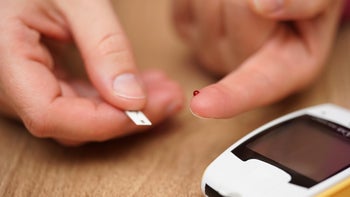
Dark Chocolate May Help Lower the Risk of Diabetes — Here Are Tips From a Dietitian
Key takeaways:
Cocoa — the active ingredient in dark chocolate — contains beneficial antioxidants, minerals, and fiber that can benefit your health.
Dark chocolate’s benefits might be particularly helpful for diabetes. Eating dark chocolate in moderation may help your body use insulin better, prevent blood sugar spikes, and lower your blood pressure.
Choose dark chocolate that’s 70% or more cocoa, and avoid chocolate with high amounts of added sugar or other additives.

Dark chocolate is beloved by many. And the good news is that it also has some health benefits. This is because its active ingredient, cocoa, contains flavanols, a powerful type of antioxidant. Cocoa also contains fiber and minerals, such as iron, zinc, magnesium, phosphorus, and selenium.
But what if you have diabetes? Since people with diabetes are typically told to limit sugars, you may wonder whether dark chocolate is OK to eat. And it is. There’s even evidence that dark chocolate can help with diabetes. Let’s dive into the research to understand how.
Is dark chocolate good for diabetes?
Dark chocolate can be a good food choice for people who have diabetes if you eat it in moderation. It’s a low-sugar food compared to many other sweets. One ounce of 72% dark chocolate has 8 g of added sugar. (The same amount of milk chocolate has about 12 g of added sugar.)
And dark chocolate may have some diabetes-specific health benefits.
Some research suggests that the flavanols in dark chocolate may help reduce the risk of developing Type 2 diabetes. But it’s important to note that other studies haven’t reached the same conclusion, so more research is needed here.
There’s more robust evidence to suggest that dark chocolate may be able to help manage diabetes if you have it.
But before we take a closer look below at the ways dark chocolate may benefit diabetes, it’s important to note that dark chocolate on its own isn’t a way to prevent or manage diabetes. Getting regular exercise, maintaining a comfortable body weight, limiting added sugars, and eating a diet rich in fruits, vegetables, and whole grains all play an important role.
It increases insulin sensitivity
Most of dark chocolate’s potential benefits are linked to plant compounds called flavanols, a type of antioxidant. And research suggests that the flavanols in dark chocolate may improve insulin sensitivity. This refers to how well your body uses insulin to regulate blood sugar levels.
Dark chocolate may improve insulin sensitivity by:
Helping your beta cells work better: Beta cells, located in your pancreas, are responsible for producing insulin.
Improving how your body breaks down glucose: Glucose is sugar from carbohydrates. It’s your body’s primary source of energy.
Reducing oxidative stress: Oxidative stress happens when free radicals build up in your body and damage cells. This cellular damage is a main cause of insulin resistance (when the body’s cells don’t respond properly to insulin).
Healthy dark chocolate snacks: Yes, certain chocolate snacks can be part of a nutritious and balanced diet. Here are some ideas.
Dark chocolate and heavy metals: Dark chocolate may contain trace amounts of cadmium and lead. It’s still considered safe for adults to eat small amounts. But here’s what to know.
Healthy snacks to try if you have diabetes: Pairing high-fiber foods with a protein source provides a nutrient-dense snack that will help keep blood sugar levels stable.
Having better insulin sensitivity helps prevent diabetes. It can also help you manage diabetes if you already have it.
It may lower blood pressure
People with diabetes are twice as likely to develop high blood pressure compared to people who don’t have diabetes. This is because high blood sugar is common in people with diabetes. And having high blood sugar can damage the lining of your blood vessels. This can lead to stiffer blood vessels, which increases blood pressure.
The research on dark chocolate’s effect on blood pressure is still emerging. Earlier data summarized by the American Heart Association (AHA) suggests that dark chocolate may be useful in both preventing and managing high blood pressure. And some small studies link dark chocolate and lower blood pressure in healthy people and in people with prediabetes. But an analysis of studies involving people with diabetes didn’t find a link between dark chocolate and lower blood pressure.
How might dark chocolate impact blood pressure? It’s likely because flavanols support the health of the lining of blood vessels and produce nitric oxide in the body. Nitric oxide is a gas that can help blood vessels open up. This leads to lower blood pressure. But more research is needed to learn about the link between dark chocolate and blood pressure.
It contains fiber
Unlike many other sweets, dark chocolate contains fiber, with about 3 g of fiber per ounce. Fiber has many health benefits, including the ability to help regulate blood sugar levels. It does this by slowing the absorption of sugar into your bloodstream. Keeping blood sugar levels stable is important for people with and without diabetes.
Best dark chocolate for diabetes
While dark chocolate can provide some health benefits, the type and amount you eat matters. It helps to remember that dark chocolate is high in flavanols, whereas other types of chocolate are not. Here are four things to look out for when choosing a dark chocolate:
70% cocoa or higher: Dark chocolate comes in different percentages of cocoa (or cacao, the unprocessed version of cocoa). This percentage tells you the amount of the cocoa solids in the chocolate. The higher the percentage of cocoa, the more antioxidants it will contain. Higher cocoa percentages also tend to provide more minerals and less sugar. The ingredients list may say “cocoa” or “cacao.” They’re nearly the same thing, except that cacao is slightly less processed than cocoa.
Low in sugar: Try to aim for dark chocolate with under 8 g of sugar per ounce.
Minimal ingredients: The best dark chocolate is free of additives like artificial flavors or preservatives. So take a look at the label. Choose dark chocolate whose ingredients are cocoa, cocoa butter, and sugar — and not much else.
What it is paired with: Just because a food contains dark chocolate doesn’t automatically make it a nutritious choice. Try to avoid chocolate-covered jelly or gummy candies, pretzels, marshmallows, or sweetened dried fruit.
Pay attention to portion size. Sticking to about an ounce per day (28 g) is a good rule of thumb. This is because dark chocolate contains:
Sugar, and can lead to blood sugar spikes if you consume high amounts
Fat
Calories
Caffeine
Trace amounts of heavy metals
Tips for adding dark chocolate to your diet
There are many ways to enjoy dark chocolate as part of a nutritious and balanced diet. Here are some ideas:
Make dark chocolate-covered fruits, such as strawberries, oranges, and apple slices. If you choose low-glycemic fruits, they won’t raise your blood sugar as much as higher-glycemic ones.
Mix raw cacao powder — the unprocessed version of cocoa — into your oatmeal.
Stir dark chocolate shavings or cacao nibs into yogurt.
Make healthy hot chocolate by mixing raw cacao powder into warmed milk of choice. You can add a touch of natural sweetener like maple syrup.
Stir some melted dark chocolate — or use cacao powder — into hot coffee for a healthier homemade mocha.
Swap out milk chocolate chips for dark chocolate chips when baking.
Enjoy dark chocolate-covered nuts like almonds, peanuts, and pistachios.
Enjoy a square or two of plain dark chocolate as a snack or with a meal.
Frequently asked questions
There’s no specific amount of chocolate that’s best for everyone to eat each day. Even though dark chocolate has health benefits, it’s best to eat it in small amounts. Your care team or a registered dietitian can help you determine the right amount of dark chocolate for you.
Peanut butter can be a good food choice for people with diabetes because it has:
A low glycemic index, which means it doesn’t cause your blood sugar to rise quickly
Healthy unsaturated fats
Fiber
Protein
Opt for peanut butter without added sugar. And keep an eye on serving size. A standard serving size is 2 tbsp.
If you’ve had too much sugar, it can help to hydrate by drinking water. Taking a walk is also a good idea since this helps improve blood sugar levels. And at your next meal, try to eat a good balance of healthy fat, protein, and vegetables that have a low glycemic index.
The bottom line
Dark chocolate is a sweet that can be enjoyed by just about everyone — including people with diabetes. Its flavanols, fiber, and minerals provide some health benefits for people with diabetes or those at risk of developing it. This is because dark chocolate may regulate blood sugar, decrease blood pressure, and help insulin do its job. Just be sure to stick to 70% dark chocolate or higher, and eat it in moderation. About an ounce per day is a good rule of thumb. But it’s best to check in with your care team about how much dark chocolate is right for you.
Why trust our experts?



References
Darand, M., et al. (2021). The effect of cocoa/dark chocolate consumption on lipid profile, glycemia, and blood pressure in diabetic patients: A meta‐analysis of observational studies. Phytotherapy Research.
Davide, G., et al. (2005). Short-term administration of dark chocolate is followed by a significant increase in insulin sensitivity and a decrease in blood pressure in healthy persons. The American Journal of Clinical Nutrition.
Davide, G., et al. (2008). Blood pressure is reduced and insulin sensitivity increased in glucose-intolerant, hypertensive subjects after 15 days of consuming high-polyphenol dark chocolate. The Journal of Nutrition.
Egan, B. M., et al. (2010). Does dark chocolate have a role in the prevention and management of hypertension?: Commentary on the evidence. Hypertension.
Giuntini, E. B., et al. (2022). The effects of soluble dietary fibers on glycemic response: An overview and futures perspectives. Foods.
Hurrle, S., et al. (2017). The etiology of oxidative stress in insulin resistance. Biomedical Journal.
Li, H., et al. (2023). Research progress of flavonoids regulating endothelial function. Pharmaceuticals.
Liu, B., et al. (2024). Chocolate intake and risk of Type 2 diabetes: Prospective cohort studies. The BMJ.
Luo, Y., et al. (2022). Flavanols from nature: A phytochemistry and biological activity review. Molecules.
Mikołajczak, N., et al. (2020). Relationships between cocoa mass percentage, surface color, free phenolic compounds content and antioxidant capacity of commercially available dark chocolate bars. Journal of Food Science and Technology.
MyFoodData. (n.d.). 72% cocoa intense dark chocolate.
MyFoodData. (n.d.). Milk chocolate bar.
MyFoodData. (n.d.). Peanut butter (smooth).
Petrie, J. R., et al. (2018). Diabetes, hypertension, and cardiovascular disease: Clinical insights and vascular mechanisms. Canadian Journal of Cardiology.
Samanta, S., et al. (2022). Dark chocolate: An overview of its biological activity, processing, and fortification approaches. Current Research in Food Science.
Shah, S. R., et al. (2017). Use of dark chocolate for diabetic patients: a review of the literature and current evidence. Journal of Community Hospital Internal Medicine Perspectives.

























